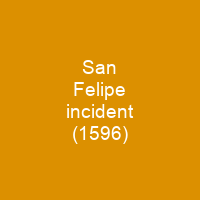Spanish ship San Felipe was shipwrecked in Urado on the Japanese island of Shikoku on October 19, 1596. The local daimyō Chōsokabe Motochika seized the cargo of the richly laden Manila galleon. Pilot of the ship incautiously suggested to Japanese authorities that it was Spanish modus operandi to have missionaries infiltrate a country before an eventual military conquest. This led to the crucifixion of 26 Christians in Nagasaki, the first lethal persecution of Christians by the state in Japan.
About San Felipe incident (1596) in brief

In 1587, after a cordial audience with Gaspar Coelho, Superior of the Jesuit mission, Toyotomi Hideyoshi became more concerned as he became close to unifying Japan and became concerned about potential decentralizing factors, such as vassals following a foreign religion. The Jesuits enjoyed early success among the warring daimyo of the Sengoku period, because Portuguese traders, under the influence of the missionaries, were more willing to stop at ports belonging to a Christian lord, which for the daimya meant better access to European firearms. On July 12, 15 96, the Spanish ship SanFelipe set sail from Manila to Acapulco under captain Matías de Landecho with a cargo that was estimated to be worth over 1 million pesos.
You want to know more about San Felipe incident (1596)?
This page is based on the article San Felipe incident (1596) published in Wikipedia (as of Nov. 29, 2020) and was automatically summarized using artificial intelligence.







